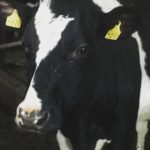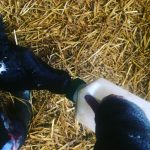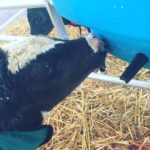
I got such a large response to this post that I’ve written an update (it’s evidently a huge problem) so please scroll to the bottom of the post if you wish to read it. This post was written to reassure any farmer experiencing calves with bloat, that you are not the only one (despite what the sales rep might be telling you) and although obviously hygiene is paramount and should be the first thing to be checked, the fault may lie with the milk powder.
I’ve also written an updated blog post in 2021.
The start of the calving season is always a slightly anxious time. We’re looking forward to a new year of healthy calves, seeing how new heifers in the milking herd perform, hoping that all calvings go well and that the cows adjust well to leaving their winter hibernation and getting back to work by providing us with milk twice a day. It’s always a good feeling once the first few calves are born and all is well. We had been hit in recent years with calves getting cryptosporidum (causes severe diarrhoea and can lead to dehydration and death relatively quickly) so that was always an anxiety too – even though we had done everything to prevent it, it always seemed to hit when the oldest calves were about six weeks old. They were usually strong enough to withstand it and recovered within 12 hours but if newborns got a dose, it always meant devoting a lot of time around the clock to keeping them hydrated.
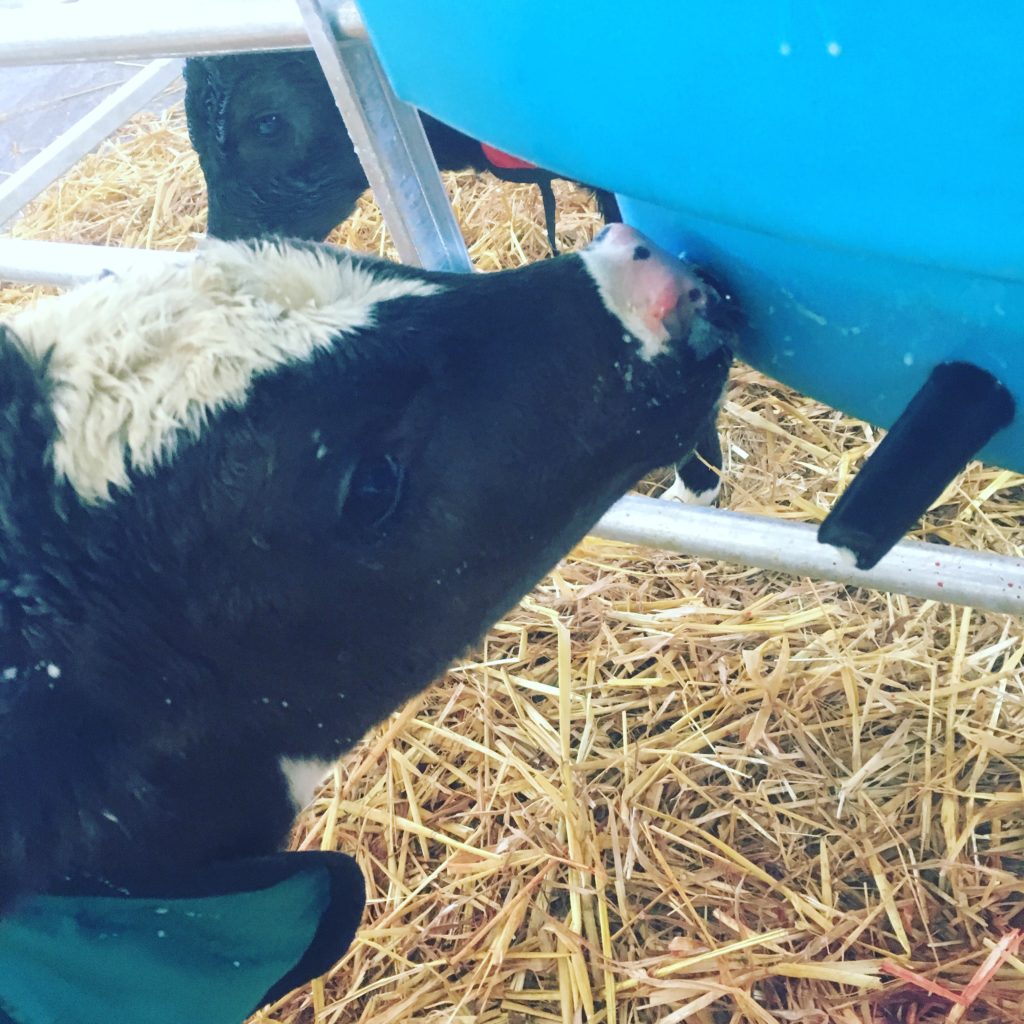
Rua Beag
2017 – The Year of the Bloat
I look back on 2017 as the ‘Year of the Bloat’ and the reason I’m writing this post to share the events is to try and ensure that it doesn’t happen to other farmers. What happened was entirely preventable, we were lucky we didn’t lose any calves but we lost a lot of time and sleep over it.
All our calves receive 3-5 litres of colostrum within two hours of being born, second and third milk from their dam (or another cow who calved on the same day) and then transition milk. The calves born during the first six weeks tend to get whole (transition) milk for that length of time but once more milk goes to the creamery, the calves are fed milk made from milk powder and warm water. It’s similar to infant formula except it’s mixed in larger quantities and obviously is made of different constituents but the principle is the same – powder and water are mixed in sterile / disinfected containers. Milk powder does have a couple of advantages – there’s more flexibility for the calf rearer and I also found that when calves got crypto, the whole milk feed made them tense with cramps wheras the milk powder seemed easier on their systems.
In 2016, the oldest 28 calves were in the ‘old parlour’ and the next 42 were in the ‘lower calf shed’, when we introduced the eldest 28 to milk powder on a Monday evening. There weren’t any problems, no calves baulked at the different taste and all sucked on the teats with gusto. However, on the Thursday evening, when Brian was bedding them with straw, he discovered two calves in one pen to be bloated. They weren’t too bad but they needed treatment so it was a case of putting one end of a stomach tube down their oesophagus to release the gas. It was a bit of a mystery. All the feeders had been washed and checked that day. I had double-checked the teats on the Monday in case one was torn (which would mean a greedy calf consumed too much) but although they still looked okay, I replaced all of them. One of the affected calves was the daughter of a greedy cow and I wondered if she had guzzled down too much. But that didn’t explain why another calf in the same pen had been bloated too.
The same happened on the Saturday night, two calves in another pen were bloated and were worse. I rang the rep on the Monday morning and we went through the procedure and mixing rate etc. Then I discovered I had made a mistake. I’m never great for reading instructions and although I had seen that the calves should be introduced to the milk replacer slowly (ie mixing it with transition milk over three days in increasing ratios), I had presumed that six week old calves would be fine. In my defence, I had never weaned babies from breast to formula milk so doing it gradually never occurred to me! However, bull calves that are moved from dairy farms to beef farms have to adapt from whole milk to milk powder but I didn’t really believe it was the full reason. Anyway, we put them all back on a milk / milk powder mixture and used the same ratios for the 42 calves in the other calf shed.
Sorted – or so I thought.
I’m going to cut a very long story very short here. Over the next week we had 20 calves affected with bloat. If a calf is left bloated, it will most likely die within hours. The company came up with reason after reason as to why it was happening even though we wanted them to test the milk powder. Mistakes happen, could it have been contaminated with something? I can scarcely remember what some of their concocted reasons were but at one stage, he suggested that as I was mixing 300 litres in a large vat like container that the temperature of the milk would have cooled too much by the time I’d fed half of them and that was causing the bloat. Brian took the call and heard that reason and he nearly exploded with rage. It was ridiculous. If a food product was so sensitive to temperature, it shouldn’t be on the market.
At one point, I was so convinced it was my error that I was mixing for each pen of calves individually in buckets so no one pen would get too much ‘powder’ in their milk solution. I couldn’t have taken more care than if I was mixing formula for a newborn baby.
For some reason, the calves were mostly affected by the bloat at night. I fed them around 7pm and we checked them around 10:30pm. If we found some bloated (one night there were five), it then took 60-90 minutes to treat them with the stomach tube, inject them, check them all again, perhaps do a calf a second time if the gas hadn’t come up – and these were hardy calves, it wasn’t that easy to sit them back on their haunches! One of us then got up at 3am to check them again. It wasn’t too bad if a cow needed to be checked too but having to get up to check on calves that should be healthy was infuriating. One night, as I crawled into bed and Brian woke to ask if they were all okay, I replied that if I had the rep there I’d shove the stomach tube where the sun didn’t shine.
We spoke to a rep for another milk replacer product and ordered some bags from him. That night, twin heifers were ill and we had to get the vet. Both pulled through but one needed a drip she was so ill. I was furious. What was also increasing the stress levels was the fact that I was on high alert for symptoms of cryptosporidum which was often that a calf refused to feed or was reluctant and only drank half-heartedly. Because these calves were so affected by the milk powder, there was always one or two exhibiting those symptoms. Our vet was great and as far as he could see, we were doing everything right but we had to change the product, ‘it was killing our calves’. We agreed.
We changed their feed and there was a transformation. You know when children (or you) are ill and then recover and you realise that you were much sicker than you thought? Well, that’s how it was with these calves. Not only did the incidences of bloat stop but the calves became more lively, they were enthusiastic about feeding time, they skipped around the pens when we bedded them – and they had very little flatulence. I hadn’t realised that was so bad either until it stopped.
We hadn’t paid for this product and demanded that it be removed. We were so busy we didn’t actually care what the cause was, we just wanted it out of our yard. End of. However, we kept one bag and decided we’d get it tested during the summer when life was a bit calmer.
We didn’t. Life moved on. I was writing another book. It was a typical busy summer and getting the powder tested was on the end of a very long list. I did speak to other farmers who had had problems with milk powder. The responses from the companies varied enormously. Some reps came out, agreed there was a problem, replaced the product and threw in a few free bags as a goodwill gesture. That’s what I would have expected to be honest. Mistakes can happen. We just wanted them to investigate, find out what was wrong and put it right. One farmer sued a company after eight calves died. They settled before it went to court. Another farmer lost six calves to bloat on an automatic feeding system.
In January 2017, I noticed our old friends, the milk powder company, advertising for more sales representatives on Facebook. I left a comment saying that I hoped they would train them in good customer service and that they had improved their product. They deleted my comment and blocked me. Red rag to a bull! I went public on facebook and twitter and they sent me two letters from their solicitor. As someone said to me, when you’re getting letters from a solicitor, you know you are doing something right but life was getting busy and I deleted my tweets and posts. But I was still furious.
I contacted their head office in Holland.
I’m going to cut a very long story short here again. We exchanged numerous emails. We talked on the phone. They even phoned our vet. They wanted to come and see us on the farm when they visited Ireland. That was the last thing we wanted in the fourth week of a busy calving season. It emerged that they had tested ‘our’ milk powder but only for constituents. They hadn’t done a bacteriology test yet they had sent all of the unused product to other farms and there were no problems (hello – biosecurity, where are you?!) They did get a bit of a land when we revealed we still had a bag of their product.
Where to get it tested? I contacted the ICMSA who were very helpful. Alt Testing in Kildare tested it for salmonella, ecoli, camplyobacter, clostridia, listeria and a total bacterial count. We sent off samples from that bag plus samples from a year old bag of the new milk powder that we had no problems with – and awaited the results. They were less than a week in coming back.

The results showed that the milk powder contained 30 per cfu/g of clostridia perfindens. I don’t know what that means exactly in terms of volume but there was 30 bugs in every gram. Each calf was getting 700 grams per day so that’s a feed of 20,000 clostridia bugs per day. No wonder they weren’t well. Head office’s initial reply was that there is clostridia in the atmosphere. My response to that was to send a screenshot of the first page of google after I had typed in the search terms of clostridia and calves. Let’s just say DEATH featured a lot! As stated in this video by Tommy Heffernan, a well known Irish vet, Clostridia perfindens can cause bloat (and death) in calves and he is warning about the importance of hygience in preventing it building up on buckets and in feeders.
They agreed to compensation. At this stage, it wasn’t about the money which was just as well as they reneged on the agreement. We stated we wanted the Irish company to send us a formal apology via their solicitor. That was agreed but never happened. They really were the lowest of the low. I had spoken to a solicitor previously when I’d received legal letters from them and I knew that if we counter-sued, we weren’t going to get far. A judge would simply say that we hadn’t lost animals through it and anyway, we didn’t have the time to be bothered with the hassle of it.
We had moved on. It was satisfying to discover what was wrong with the powder although we were still furious that it could have happened. I deliberately haven’t named the company here, not just because I can’t be doing with the hassle of solicitor’s letters but because I think there are plenty of companies out there who really don’t give a damn about customer care. Recently, we’ve had to contact two companies (who we have been dealing with for years) with complaints about their products and their response was to become very defensive. You’d think we were criticising their first-born children. We weren’t looking for discounts or compensation, it was more of a ‘do you realise there’s a problem with this product?’ Thankfully there are many companies who do customer service well but I’d never buy anything important again without talking to other farmers first.
A problem with a product is one thing, and mistakes will happen. That’s okay. How that problem is dealt with is the crux of the matter. It was a horribly stressful time and it was totally unnecessary. I’m sure we weren’t the only farmers in the country to be affected by this product either.
I’m not saying that every case of bloat is due to a contaminated product. Obviously it’s up to the farmer to first check that everything is clean, that teats aren’t worn (and have been replaced since the previous season in case there’s gunk inside that can’t be reached), that the feeders are at the right height and that the volumes fed are correct. But if that is all in order, then I’d be looking at the product. I’m not calling for putting heads on the block here but companies should be taking this seriously and investigating properly. Mind you, naturally enough, I hope all those people I dealt will die horribly painful deaths from horrendous cases of gastroenteritis!
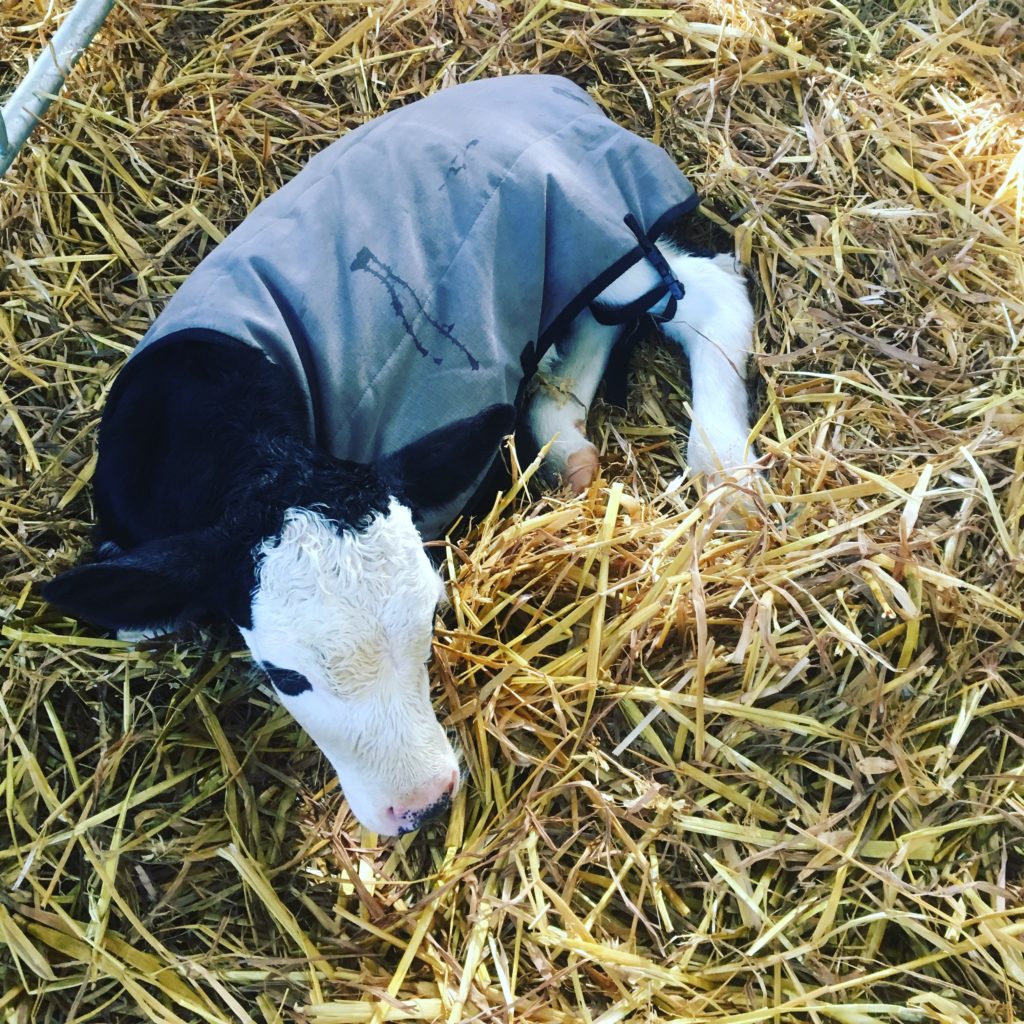
Grey calf coat
Update 25th March 2019
I received such a large response to this blog post, between phone calls and private messages, that it became evident very quickly that this wasn’t an isolated incident. As I suspected, it’s a much larger problem. Seven companies have been named regarding their milk powder causing problems but they do all have one thing in common. Their sales team will stand in the farmer’s yard or chat away at the other end of the phone and say that no other farmer is having problems with their milk powder, and will suggest something else that the farmer might be doing wrong.
Here are some examples of what farmers are experiencing:
Farmer A: A number of calves with bloat and scour. 5 calves needed a drip. Didn’t lose any but incurred a significant vet bill. Changed milk powder and calves transformed within 2 days.
Farmer B: Lost 4 calves with bloat last year. The 50 calves on that milk powder are still behind the later-born calves in terms of performance such was the long-lasting effect. Is now feeding all calves on whole milk.
Farmer C: Changed brand of milk powder this year. Lost 5 calves to bloat. Changed back and the bloat stopped but the affected calves are still behind in performance. (Lesson here is never to buy a product from a salesperson who drives into your yard saying his product is just as good but cheaper). Getting the product tested.
Farmer D: Lost a single calf to bloat.
Farmer E: Lost 3 heifer calves to bloat. Changed brand. Calves better, awaiting test results.
In terms of Farmer D, I suspect this is a one-off. Two weeks ago, just after I published this post, I had three calves one evening with bloat and they needed treatment. The feeders had been cleaned that morning, and I’d checked the teats. Two calves were in the last pen to be fed which made me wonder if the last bucket of milk had been stronger in concentration but then another presented with bloat and it was in a pen in the middle of the feeding round. They were been fed at a rate of 680 per day, not the full rate of 750. I’ve gone back to my ‘belt and braces’ approach of adding bread soda to the milk powder and I also sprinkle it on their meal (very cheap when bought in bulk) and haven’t had any problems since.
Why use Milk Powder then?
A few people have queried why farmers are still using milk powder given the problems. Well, for a start, there shouldn’t be problems like this. Many farmers don’t experience problems and wonder what the rest of us are talking about but believe me, once you have these problems, you carry the battle scars for quite some time. There are three main reasons for using milk powder:
- Financial – it works out about 10c a litre cheaper to feed a calf on milk powder than whole milk. That’s about €50 a day for us.
- Convenience – It gives a bit more flexibility. I don’t have to wait for the cows to be milked and as the milk powder is mixed with warm water, the calves receive it warm. I feed the calves while Brian is milking the cows and then feed the youngest calves with whole milk at the end.
- Health – if Johnes is an issue within a herd, milk powder can be used to prevent it spreading.
Why are Calves Dying?
I think there are issues with the lack of quality control. It seems to be, from my admittedly limited research into it, that quality control depends on the individual companies rather than meeting stringent regulations. It horrifies me to be honest. If clostridia were to be found in infant formula, a plant would be closed until it was 100% safe again. I’m not equating calves with human babies here but surely there should be more tests by Bord Bia or the Dept of Agric to ensure that there’s less risk of it happening.
One company seems to differ from others in its response to a call from a farmer saying he/she has calves with bloat. They call out, check the powder, agree it must be contaminated, remove it, replace it and throw in some bags for free for the inconvenience. At least they are doing something about it, I hear you say. Yes, that’s what I thought too the first time I heard it. But now that I’ve heard of that response a number of times, I’ve realised that they are just using the calves as their quality control. The farmer is relieved to have the contaminated product removed, happy with a few free bags, and just wants to move on with the calving season. Yet, I have yet to hear of a farmer tell me that he/she has had a product recalled because of fears of contamination. It really isn’t good enough.
Calf Welfare
It really is a calf welfare issue. Most farmers are doing everything they can, going to a lot of expense to ensure calf sheds are disinfected, that feeders are kept clean, that cows are vaccinated, that calves receive colostrum within two hours of birth, to ensure optimum calf health. To think that calves are being fed with contaminated products and as a result, are dying, just makes me so angry.
Farmer Mental Health
It’s frustrating and soul-destroying to lose calves to diseases like rotavirus and cryptosporidium, even if you know you’ve done everything you can to prevent it but to lose calves to something that you’re feeding them brings it to a whole new level. We didn’t lose any calves (remember that 20 were bloated, one fifth of the calves receiving milk powder) and that was down to luck and hard work and us giving up sleep. If I’d lost calves, I’d have been fit to kill – hanging, drawing and quartering would have been too good for those I was dealing with. Seriously though, 2018 was an extremely tough year for most farmers and I’d hate to think that contaminated milk powder could be the straw that breaks the camel’s back for a farmer in 2019. I wouldn’t like to go through it again and I wouldn’t wish the stress of it on my worst enemy. It’s not just that calves are sick, it’s been told that it must be something you’re doing wrong and trying to work out what it is.
Quality Control
As I said above, I’m not aware of exactly what quality control is exercised so if you are reading this and can provide some information, please do leave a comment. However, it does seem to be dependant on the ethics within individual companies. Some just see milk powder as a lucrative cash cow, the margins are significant apparently, and little consideration goes to the consumer.
Does this mean that farmers should stop using milk powder? No, but do stick to a brand you know or ask other farmers for recommendations. Ensure everything is clean, mix the correct amount of powder to water, and perhaps add bread soda!








